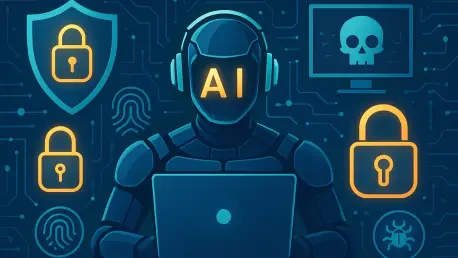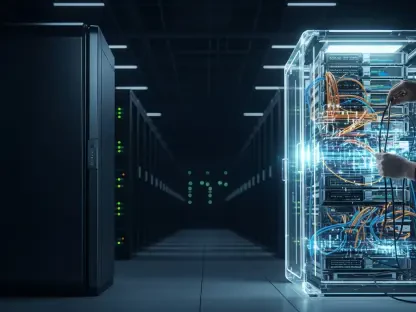In the rapidly evolving digital landscape, Chief Information Security Officers (CISOs) are increasingly alert to the growing threat of AI-powered cyberattacks. This development is not merely a theoretical risk; it represents a clear and present danger that has prompted AI-related concerns to take precedence over more traditional cybersecurity issues. Recent findings indicate that AI-driven threats have moved to the forefront, surpassing traditional concerns such as vulnerability management and data loss prevention. With one in four CISOs reporting AI-generated attacks, the actual number could be higher as these sophisticated threats often impersonate human actions, complicating detection efforts.
The Dual Challenge: Security and Integration
Securing AI-Driven Threats
The pressing issue for CISOs today encompasses not only protection against AI-based threats but also adopting these very technologies within their organizations. This dual challenge requires a delicate balance between implementing advanced security measures and fostering innovation through AI tools. A pivotal factor in this balance is the pressure from corporate boards that advocate for greater AI integration. This has made it imperative for CISOs to establish robust security and privacy policies. Notably, a significant percentage of security leaders focus on securing AI agents and aligning AI tool usage with their organization’s policies to mitigate risks in this dynamic environment, characterized by its evolving threat landscape and immature controls.
An examination of the current cybersecurity landscape reveals a strategic pivot as enterprises increasingly rely on AI technology. Security executives are under growing pressure to ensure that AI applications are both beneficial and secure. With nearly 37% of them steering efforts towards AI agent security, the role of CISOs has expanded. This shift is particularly evident in the pressures faced by these security leaders to bridge the gap between conducting thorough AI risk assessments and driving enterprise-wide AI adoption. As a result, there is a palpable tension between utilizing AI’s potential and navigating its security pitfalls, urging the need for strategic foresight and adaptive governance.
Balancing AI Use and Risk
Incorporating artificial intelligence into the cybersecurity framework introduces a dynamic shift, presenting CISOs with both opportunities and risks. Nearly 80% of CISOs are considering AI as a means to promote efficiency, underscoring the anticipated AI-driven transformation of Security Operations Centers (SOCs). This transition is driven largely by the promise of reducing workforce burdens. Moreover, the aspiration to utilize AI extends to areas such as penetration testing and third-party risk assessments, where CISOs are grappling with resource constraints and the growing complexity of threats. As these organizations seek to harness AI’s potential, the focus remains on achieving actionable and resilient security outcomes.
Despite the enthusiasm surrounding AI-driven solutions, there exists a cautious approach toward external vendor offerings, as evidenced by over two-thirds of companies opting to develop AI capabilities in-house. This trend reflects a desire to maintain control and customization over AI systems, ensuring they meet specific security needs and integrate seamlessly within existing frameworks. The move to develop AI internally also highlights an understanding of the bespoke requirements that different organizations possess. It emphasizes the need for cybersecurity strategies to be tailored to the unique challenges and threat profiles faced by each entity.
Strategic AI Adoption and the Road Ahead
In-House Development of AI Models
The inclination towards developing AI solutions internally highlights an important facet of modern cybersecurity strategies. This choice allows organizations to retain paramount control over proprietary systems while navigating security-specific concerns particular to the organization. Creating AI solutions in-house not only mitigates potential security risks but facilitates tailoring AI applications to the unique operational challenges they encounter. The preference for customized AI solutions is a reaction to increasingly sophisticated cyber threats, which demand innovative, adaptable responses rather than one-size-fits-all solutions. This strategy capitalizes on existing technical expertise, allowing organizations to develop robust, effective defenses aligned with their specific requirements.
Additionally, the trend towards self-developed AI tools indicates a broader hesitancy about external reliance. By focusing efforts internally, CISOs can leverage their teams’ extensive knowledge of organizational ecosystems and threat landscapes to design more effective tools. This process ensures that AI integrations are not just effective in mitigating vulnerabilities but also enhance the overall resilience of their operations. This strategic shift underlines a critical reassessment of vendor dependencies, setting the stage for more sustainable cybersecurity protocols that prioritize internal strengths, informed by direct threat intelligence and operational insights.
Governing AI Integration
As AI continues to be an integral element of cybersecurity strategies, the need for governance frameworks becomes imperative. These frameworks are essential to guide the effective use of AI while ensuring alignment with security standards. Effective governance not only facilitates smoother AI adoption but also ensures that AI tools adhere to rigorous security practices, safeguarding sensitive information. By establishing governance structures, organizations can better manage the risks associated with AI deployment, from ensuring compliance to preventing misuse. Such frameworks serve as the backbone for fostering an environment where AI can be leveraged responsibly, offering a pathway to secure and innovative digital transformations.
Moreover, strong governance is instrumental in establishing transparency and accountability in AI integration processes. As organizations strive to harness AI’s potential, they must also prepare for the ethical implications its deployment may bring. The complexities surrounding AI-assisted decisions necessitate robust regulatory oversight. By adopting comprehensive governance measures, organizations can address the intrinsic challenges of AI technologies, enabling them to thrive in an era defined by rapid technological advancements. This focus on governance highlights a proactive approach to ensuring cybersecurity remains a steadfast priority, even amid technological evolution.
Future Directions in Cybersecurity
A New Era of Threat Management
The cybersecurity arena is rapidly transforming with AI playing a central role in threat management. As AI technology matures, CISOs must continue evolving their strategies to anticipate and mitigate emerging threats efficiently. The focus has shifted from merely identifying risks to proactively anticipating potential vectors of attack, ensuring that organizations remain one step ahead of adversaries. With AI becoming a staple in the cybersecurity toolkit, its role is not just confined to threat detection but extends to strategic planning and dynamic response mechanisms.
Looking forward, it is expected that AI will become an indispensable ally in counteracting sophisticated cyber threats. As organizations embrace AI for its unparalleled advantages, they must also navigate the challenges it poses with foresight and precision. Central to future defense strategies will be the empowerment of CISOs with advanced AI tools capable of swiftly adapting to evolving threats while offering analytical insights that translate into actionable intelligence. By fostering an environment that encourages innovation without compromising security, leaders can ensure that their organizations not only survive but thrive in the face of growing AI-driven cyber challenges.
The Role of Human Insight
In today’s fast-paced digital world, Chief Information Security Officers (CISOs) are becoming increasingly vigilant about the growing menace of cyberattacks powered by artificial intelligence. This is not just a potential issue; it’s a substantial and immediate threat that has shifted AI-related concerns to the forefront of cybersecurity priorities, overshadowing more conventional issues. Recent studies highlight that AI-driven risks now top the list for security professionals, outpacing traditional challenges like vulnerability management and data loss prevention. Alarmingly, one in four CISOs have already faced AI-generated attacks, and the true number might be even higher. These highly advanced threats mimic human behavior, making it difficult to detect and thwart them. This complexity underscores the urgent need for improved defenses and strategies tailored to address AI-powered threats. As technology continues to evolve, it’s clear that CISOs must adjust their approaches to safeguard against these AI-enhanced cyber threats effectively.









